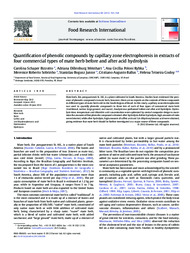Quantification of phenolic compounds by capillary zone electrophoresis in extracts of four commercial types of mate herb before and after acid hydrolysis.
Quantification of phenolic compounds by capillary zone electrophoresis in extracts of four commercial types of mate herb before and after acid hydrolysis.
Author(s): BIZZOTTO, C. S.; MEINHART, A. D.; RYBKA, A. C. P.; ROBERTO SOBRINHO, M.; BOGUSZ JUNIOR, S.; BALLUS, C. A.; GODOY, H. T.
Summary: Mate herb, Ilex paraguariensis St. Hil., is a plant cultivated in South America. Studies have evidenced the presence of phenolic compounds in mate herb, however, there are no reports on the contents of these compounds in different types of mate herb sold in the South Region of Brazil. In this study, capillary zone electrophoresis was used to quantify phenolic compounds in three lots of each of four types of commercial mate herb (traditional, native, large ground, and suave). Analysis was performed before and after acid hydrolysis. Hydro- lysis time, temperature and chloridric acid concentration were optimized by central composite design to maximize the amounts of free phenolic compounds obtained after hydrolysis. Before hydrolysis, high amounts of rutin were detected, while after hydrolysis, high amounts of caffeic acid and 3,4-dihydroxybenzoic acid were obtained, giving evidence that mate herb should be further investigated as a major source of these compounds
Publication year: 2012
Types of publication: Journal article
Unit: Embrapa Semi-arid Region
Observation
Some of Embrapa's publications are published as ePub files. To read them, use or download one of the following free software options to your computer or mobile device. Android: Google Play Books; IOS: iBooks; Windows and Linux: Calibre.
Access other publications
Access the Agricultural Research Database (BDPA) to consult Embrapa's full library collection and records.
Visit Embrapa Bookstore to purchase books and other publications sold by Embrapa.

